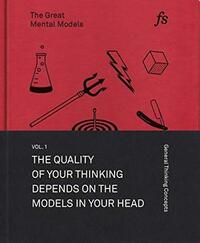Take a photo of a barcode or cover
107 reviews for:
The Great Mental Models: General Thinking Concepts
Shane Parrish, Rhiannon Beaubien
107 reviews for:
The Great Mental Models: General Thinking Concepts
Shane Parrish, Rhiannon Beaubien
fast-paced
informative
lighthearted
reflective
Overall a great and informative read, but some of the ideas in this book are too generalized to the point where you can't take anything practical away from it.
The book introduces you to basic thinking models. I had come across many of these when I had read Farnam Street blog. This book brings them together and provides context to each thinking model. The author tags each mental model to an event from history to ensure that we appreciate the significance of the model.
informative
medium-paced
Being an optimistic engineer who enjoys reading behavioral psychology books, I didn't learn much new in this volume. I did like the _inversion_ chapter as a new way to think about working backwards.
All in all, the content of the Farnam Street blog is much higher quality and deeper than this high level book.
All in all, the content of the Farnam Street blog is much higher quality and deeper than this high level book.
informative
lighthearted
medium-paced
Just an excerpt from Farnam Street blog (https://fs.blog). If you have read it, the book may not provide much interesting to you.
So, it's useful information, no doubt. If you haven't heard of the ideas presented in the index of this book, it's a great way to familiarize yourself with them, and has plenty of fun, cerebral anecdotes to get you there.
The problem is that if you know the phrase "mental models", you probably are familiar with the ideas in this book already. The main value isn't in the mental models themselves or having them described, but being able to apply them to real-life situation that you might be facing. I don't know of a technique or way to incorporate these ideas into daily life so that they readily come to mind as you need them (which is sort of the point).
I guess having them described is a good first step, though.
The problem is that if you know the phrase "mental models", you probably are familiar with the ideas in this book already. The main value isn't in the mental models themselves or having them described, but being able to apply them to real-life situation that you might be facing. I don't know of a technique or way to incorporate these ideas into daily life so that they readily come to mind as you need them (which is sort of the point).
I guess having them described is a good first step, though.
A quick read overview of mental models
This book is adapted from a series of blog posts, which makes it a good overview and quick read. Each chapter speaks to one mental model, describing it and then providing 2-3 examples from history. The only negative for me was that in a couple chapters I felt the examples were a bit of a stretch to support the theory he just defined. I didn’t quite believe it and he even acknowledges in one that he can’t truly know what led a historical figure to make a certain decision. Nothing in the book was brand new to me, but I liked the framing of each as mental models as I can now tie the concepts more neatly together when discussing with colleagues at work.
This book is adapted from a series of blog posts, which makes it a good overview and quick read. Each chapter speaks to one mental model, describing it and then providing 2-3 examples from history. The only negative for me was that in a couple chapters I felt the examples were a bit of a stretch to support the theory he just defined. I didn’t quite believe it and he even acknowledges in one that he can’t truly know what led a historical figure to make a certain decision. Nothing in the book was brand new to me, but I liked the framing of each as mental models as I can now tie the concepts more neatly together when discussing with colleagues at work.
Delivered on what it promised and more. I loved how succinct and simple it was. The historical anecdotes and supplementary concepts were very relevant and helped me apply these models.
This is one of those books that I'll definitely be referring back to over the next few years until I've fully internalized it. Regardless, I think anyone who's interested in developing better patterns of thought should read this one.
If only a lot of books were as succinct and thoughtful as this. (Sigh 48 Laws)
Here are the concepts simplified. I do think that it's more important to actually apply them than to know about them, though.
- The Map is not the Territory : A representation doesn't tell the whole story. Reality Check.
- The Circle of Competence : Know what you don't know. Know what you can't know.
- First Thinking Principles : Go back to basics and question the world
- Thought Experiment : Imagine the Possibilities
- Second-Order Thinking: And then what?
- Probabilistic Thinking: Bayes, Taleb, and Antifragility
- Inversion: Start from a different place
- Occam's Razor: Keep it simple
- Hanlon's Razor: Don't assume the worst
This is one of those books that I'll definitely be referring back to over the next few years until I've fully internalized it. Regardless, I think anyone who's interested in developing better patterns of thought should read this one.
If only a lot of books were as succinct and thoughtful as this. (Sigh 48 Laws)
Here are the concepts simplified. I do think that it's more important to actually apply them than to know about them, though.
- The Map is not the Territory : A representation doesn't tell the whole story. Reality Check.
- The Circle of Competence : Know what you don't know. Know what you can't know.
- First Thinking Principles : Go back to basics and question the world
- Thought Experiment : Imagine the Possibilities
- Second-Order Thinking: And then what?
- Probabilistic Thinking: Bayes, Taleb, and Antifragility
- Inversion: Start from a different place
- Occam's Razor: Keep it simple
- Hanlon's Razor: Don't assume the worst




